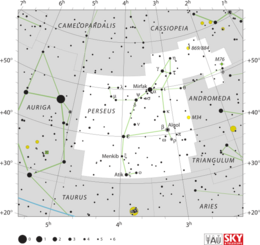Astronomy:Mu Persei
| Observation data Equinox J2000.0]] (ICRS) | |
|---|---|
| Constellation | Perseus |
| Right ascension | 04h 14m 53.86253s[1] |
| Declination | +48° 24′ 33.5912″[1] |
| Apparent magnitude (V) | +4.16[2] |
| Characteristics | |
| Spectral type | G0Ib[3] + B9.5[4] |
| B−V color index | 0.935±0.002[5] |
| Astrometry | |
| Radial velocity (Rv) | 26.46[6] km/s |
| Proper motion (μ) | RA: 5.52[1] mas/yr Dec.: −17.37[1] mas/yr |
| Parallax (π) | 3.62 ± 0.20[1] mas |
| Distance | 900 ± 50 ly (280 ± 20 pc) |
| Absolute magnitude (MV) | −3.08[5] |
| Orbit[7] | |
| Period (P) | 284 d |
| Semi-major axis (a) | 18.8 ± 8.8 mas |
| Eccentricity (e) | 0.062 |
| Inclination (i) | 74 ± 24° |
| Longitude of the node (Ω) | 296 ± 18° |
| Periastron epoch (T) | 2,420,062 |
| Argument of periastron (ω) (secondary) | 302° |
| Details | |
| Radius | ~53[8] R☉ |
| Luminosity | ~2030[8] L☉ |
| Surface gravity (log g) | 1.74[9] cgs |
| Temperature | 5418[9] K |
| Metallicity [Fe/H] | 0.09[9] dex |
| Rotational velocity (v sin i) | 12[10] km/s |
| Other designations | |
| Database references | |
| SIMBAD | data |
Mu Persei, Latinised from μ Persei, is a binary star system in the northern constellation of Perseus. It is visible to the naked eye as a point of light with a combined apparent visual magnitude of +4.16.[2] The distance to this system is approximately 900 light-years based on parallax measurements.[1] It is drifting further away with a radial velocity of +26 km/s.[6]
Mu Persei is a spectroscopic binary with an orbital period of 284 days and an eccentricity of about 0.06.[7] The primary component is a yellow G-type supergiant star. With an effective temperature of about 5,400 K and a radius of 53 solar radii, this star has the luminosity of about 2,030 times that of the Sun.[8] The companion is a B-type star with a class of B9.5[4]
Mu Persei is moving through the galaxy at a speed of 35.6 km/s relative to the Sun. Its projected galactic orbit carries it between 23,900 and 32,400 light-years from the center of the galaxy.[12]
Mu Persei came closest to the Sun 5.6 million years ago when it had brightened to magnitude 3.25 from a distance of 600 light-years.[12]
Naming
In Chinese, 天船 (Tiān Chuán), meaning Celestial Boat, refers to an asterism consisting of μ Persei, η Persei, γ Persei, α Persei, ψ Persei, δ Persei, 48 Persei and HD 27084. Consequently, μ Persei itself is known as 天船七 (Tiān Chuán qī, English: the Seventh Star of Celestial Boat).[13]
References
- ↑ 1.0 1.1 1.2 1.3 1.4 1.5 van Leeuwen, F. (2007). "Validation of the new Hipparcos reduction". Astronomy and Astrophysics 474 (2): 653–664. doi:10.1051/0004-6361:20078357. Bibcode: 2007A&A...474..653V. http://www.aanda.org/index.php?option=com_article&access=bibcode&Itemid=129&bibcode=2007A%2526A...474..653VFUL.
- ↑ 2.0 2.1 Ducati, J. R. (2002). "VizieR Online Data Catalog: Catalogue of Stellar Photometry in Johnson's 11-color system". CDS/ADC Collection of Electronic Catalogues 2237. Bibcode: 2002yCat.2237....0D.
- ↑ Keenan, Philip C.; McNeil, Raymond C. (1989). "The Perkins catalog of revised MK types for the cooler stars". Astrophysical Journal Supplement Series 71: 245. doi:10.1086/191373. Bibcode: 1989ApJS...71..245K.
- ↑ 4.0 4.1 Pantaleoni González, M.; Maíz Apellániz, J.; Barbá, R. H.; Negueruela, I. (January 2020). "A Catalog of Galactic Multiple Systems with a Red Supergiant and a B Star". Research Notes of the AAS 4 (1): 12. doi:10.3847/2515-5172/ab712b. 12. Bibcode: 2020RNAAS...4...12P.
- ↑ 5.0 5.1 Anderson, E.; Francis, Ch. (2012), "XHIP: An extended hipparcos compilation", Astronomy Letters 38 (5): 331, doi:10.1134/S1063773712050015, Bibcode: 2012AstL...38..331A.
- ↑ 6.0 6.1 Soubiran, C.; Bienaymé, O.; Mishenina, T. V.; Kovtyukh, V. V. (2008). "Vertical distribution of Galactic disk stars. IV. AMR and AVR from clump giants". Astronomy and Astrophysics 480 (1): 91–101. doi:10.1051/0004-6361:20078788. Bibcode: 2008A&A...480...91S.
- ↑ 7.0 7.1 Alden, Harold L. (1925). "Apparent orbit of μ Persei". Astronomical Journal 36 (851): 81–82. doi:10.1086/104676. Bibcode: 1925AJ.....36...81A.
- ↑ 8.0 8.1 8.2 MU PER (Mu Persei)
- ↑ 9.0 9.1 9.2 Luck, R. Earle (2014). "Parameters and Abundances in Luminous Stars". The Astronomical Journal 147 (6): 137. doi:10.1088/0004-6256/147/6/137. Bibcode: 2014AJ....147..137L.
- ↑ de Medeiros, J. R.; Udry, S.; Burki, G.; Mayor, M. (2002). "A catalog of rotational and radial velocities for evolved stars. II. Ib supergiant stars". Astronomy and Astrophysics 395: 97–98. doi:10.1051/0004-6361:20021214. Bibcode: 2002A&A...395...97D. http://www.aanda.org/articles/aa/pdf/2002/43/aa2890.pdf.
- ↑ "* mu. Per". SIMBAD. Centre de données astronomiques de Strasbourg. http://simbad.u-strasbg.fr/simbad/sim-basic?Ident=%2A+mu.+Per.
- ↑ 12.0 12.1 Mu Persei (HIP 19812)
- ↑ (in Chinese) AEEA (Activities of Exhibition and Education in Astronomy) 天文教育資訊網 2006 年 7 月 11 日
 |

